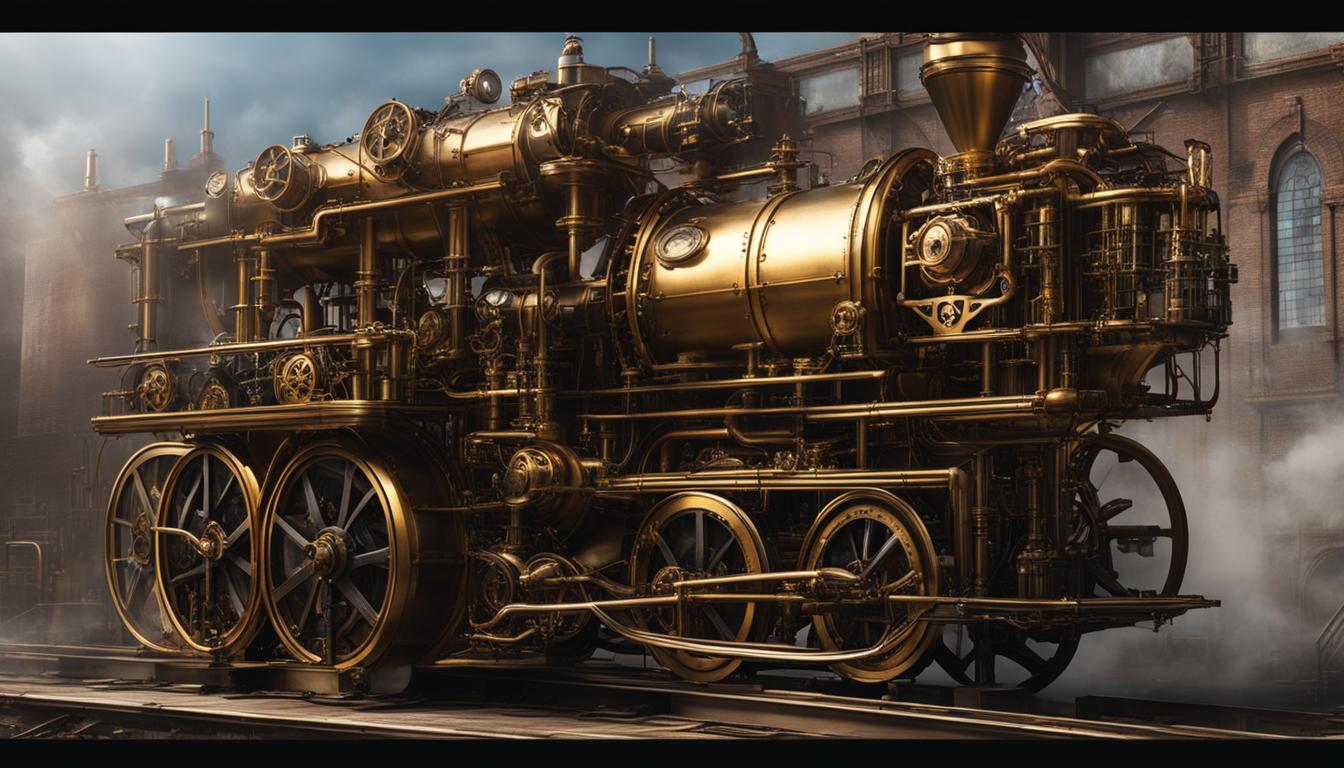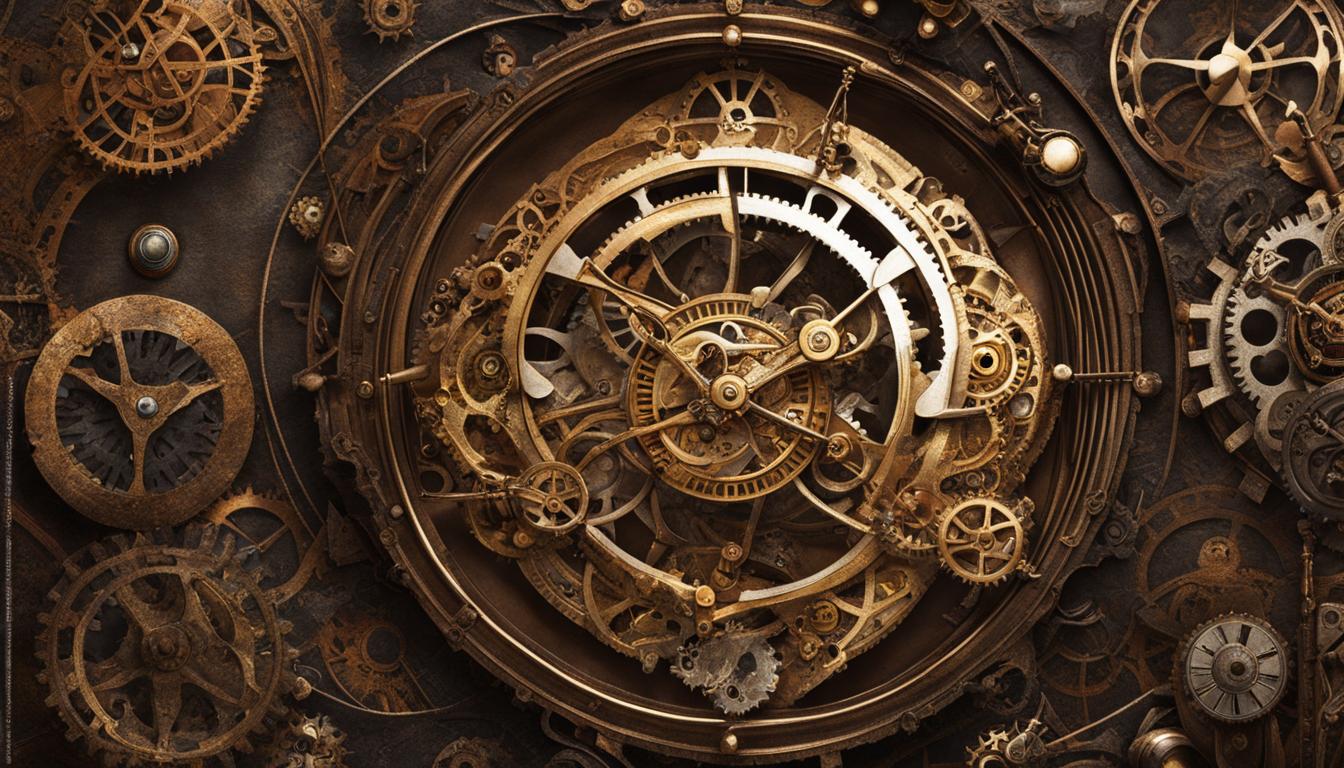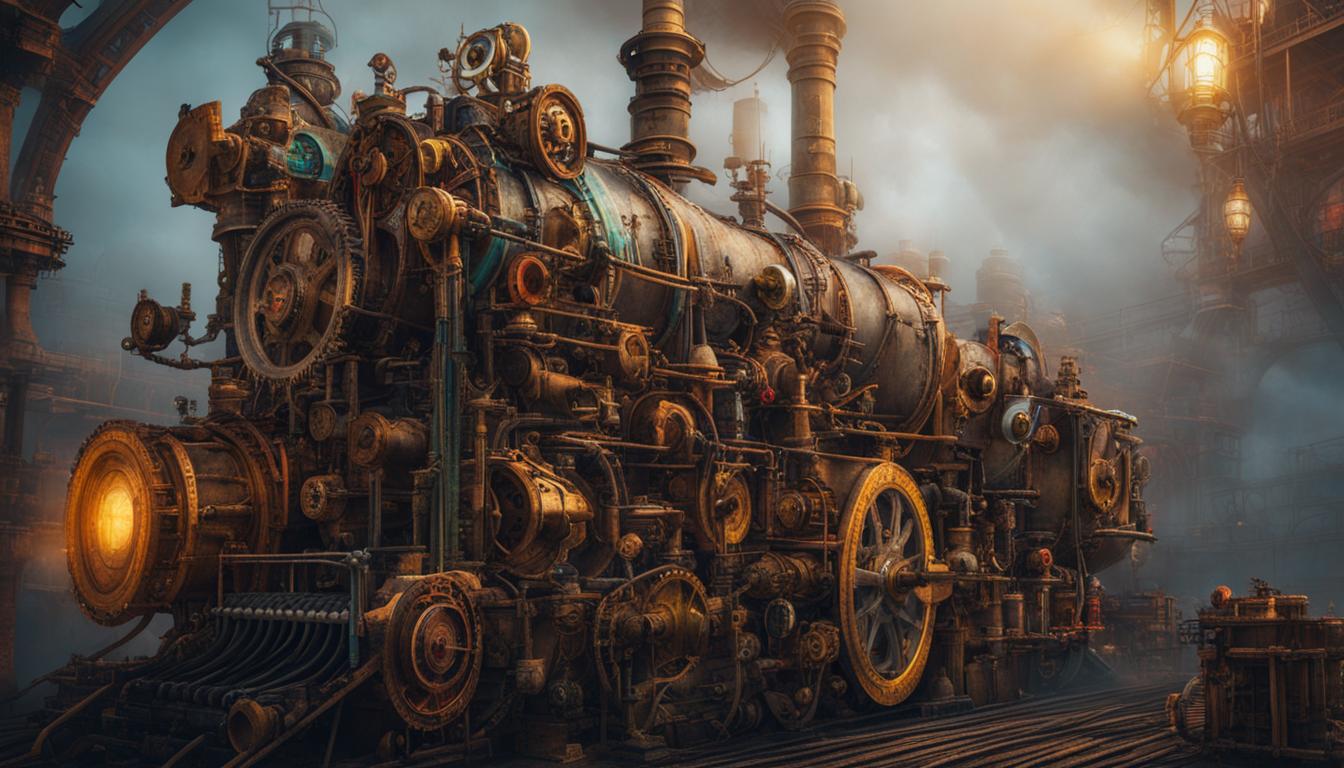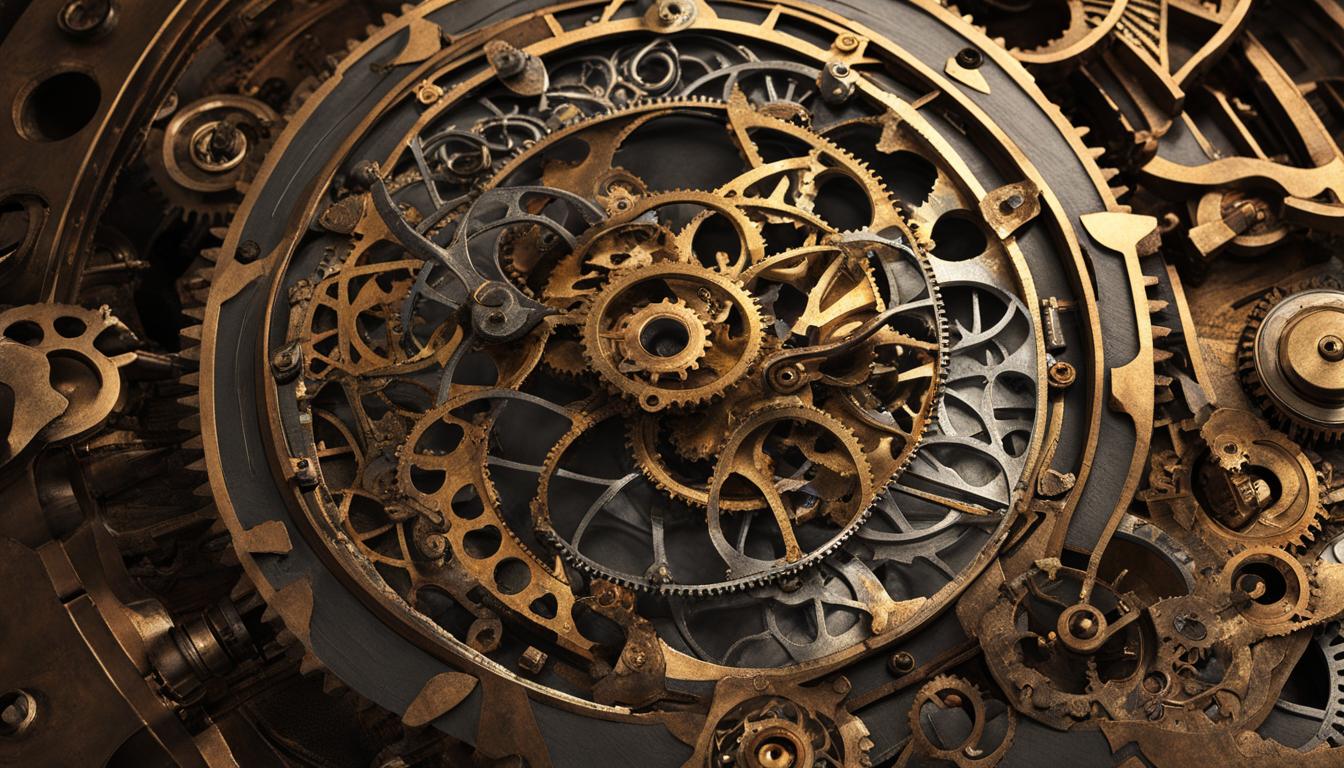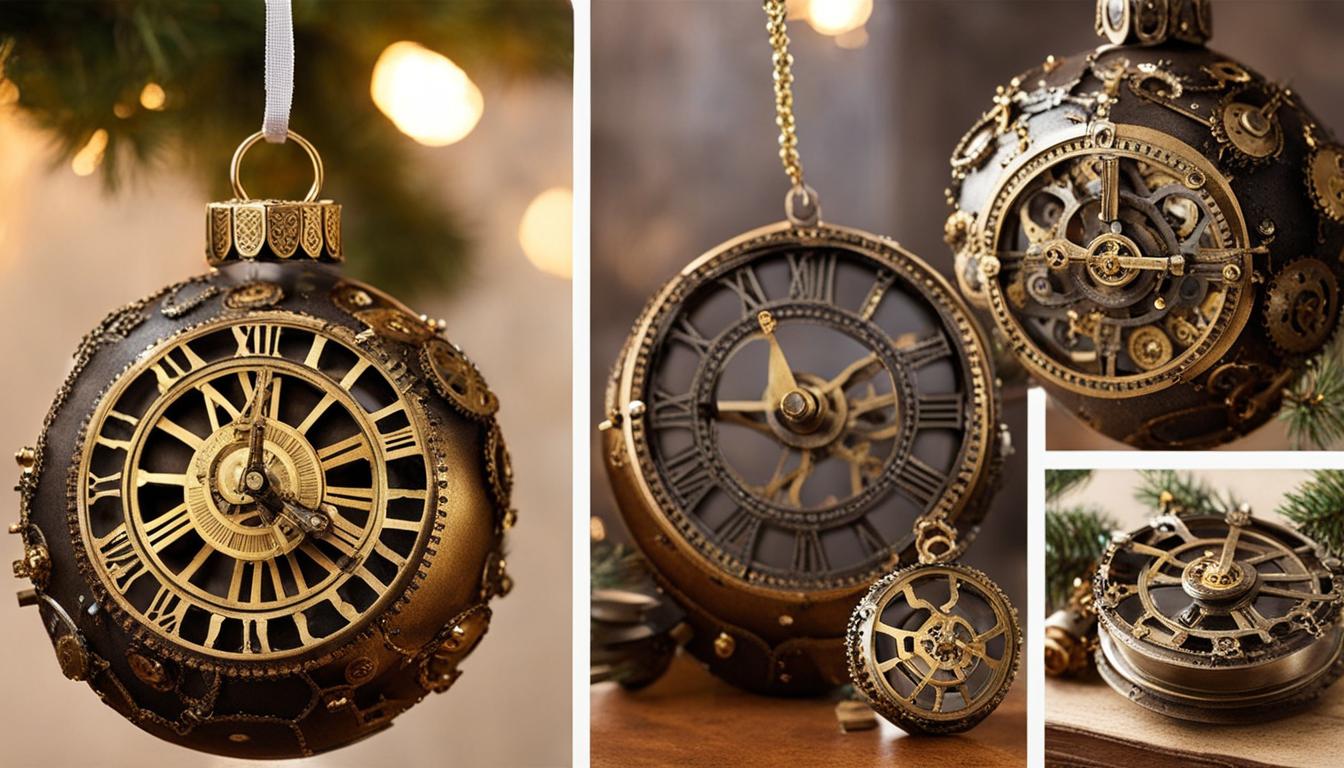Steampunk machinery is a fascinating fusion of Victorian aesthetics and innovative engineering. It captures the imagination with its intricate and visually appealing mechanisms. If you’ve ever wondered how to craft functional steampunk devices or create working steampunk machines, this guide is for you.
To embark on your journey of crafting functional steampunk machinery, it’s essential to understand the components that bring these machines to life. Boilers, engines, valves, gears, and more work harmoniously to create the captivating world of steampunk. With the right knowledge and techniques, you can bring your steampunk visions to life.
Key Takeaways:
- Functional steampunk machinery combines Victorian aesthetics with innovative engineering.
- Components such as boilers, engines, valves, and gears are vital for crafting functional steampunk devices.
- Understanding construction techniques and materials is crucial for creating working steampunk machines.
- Craftsmanship, creativity, and attention to detail play a significant role in assembling functional steampunk devices.
- Embrace the spirit of steampunk and let your imagination soar as you bring Victorian-inspired machinery to life.
Designing Mechanical Steampunk Projects
When it comes to designing mechanical steampunk projects, it’s all about striking the perfect balance between aesthetic appeal and functional ingenuity. Steampunk enthusiasts have embraced the challenge of creating unique and innovative machinery that showcases the beauty of Victorian-era aesthetics combined with cutting-edge engineering. By incorporating elements such as old radios, typewriter keys, brass, wood, and acrylic, steampunk designers can breathe life into their creations and make them truly stand out.
One remarkable example of a mechanical steampunk project is a captivating entertainment system that combines a guitar amplifier, sound system, and even robotic pop-up candles. This stunning piece of machinery incorporates a wide array of materials and components to create a visual masterpiece. Vintage radios are repurposed as speaker grilles, typewriter keys are used as control buttons, and brass details add a touch of elegance. The intricate craftsmanship and attention to detail make this steampunk entertainment system a true work of art.
When it comes to construction techniques in steampunk machinery, innovation is key. Steampunk designers often combine traditional craftsmanship with modern technology to bring their ideas to life. From sewing and woodworking to metalworking and painting, a variety of skills and techniques are utilized to assemble functional and visually appealing steampunk devices. With the right tools, materials, and a dash of creativity, the possibilities are endless.
The Beauty of Steampunk Aesthetics
“Steampunk design allows us to reimagine a world where old meets new, where the past and future coexist in perfect harmony.” – Steampunk Enthusiast
The beauty of steampunk aesthetics lies in its ability to transport us to an alternate reality where steam-powered machinery reigns supreme. Every cog and gear is meticulously placed, every detail carefully considered, creating a sense of wonder and curiosity. The fusion of Victorian elegance with futuristic technology sparks our imagination and invites us to explore uncharted territories.
| Steampunk Aesthetics | Features |
|---|---|
| Victorian Influences | Ornate detailing, luxurious materials, and an emphasis on craftsmanship |
| Industrial Elements | Gears, pipes, and rivets reminiscent of the industrial revolution |
| Antique Technology | Repurposing old objects into functional and decorative elements |
| Fantasy and Adventure | Inspiring stories of exploration, airships, and fantastical inventions |
Steampunk design encourages us to step back in time while embracing the possibilities of the future. By combining mechanical prowess with artistic expression, designers can create extraordinary machinery that captivates the imagination of all who encounter it.
Assembling Functional Steampunk Devices
When it comes to assembling functional steampunk devices, the process is a delightful blend of craftsmanship, creativity, and imagination. Whether you’re a seasoned DIY enthusiast or a novice looking to explore the world of steampunk, there are a variety of skills and techniques that can help bring your mechanical creations to life.
Skills and Tools for DIY Steampunk Mechanical Crafts
DIY steampunk mechanical crafts encompass a wide range of disciplines, including sewing, woodworking, painting, leatherworking, and metalworking. Each of these skills contributes to the overall aesthetic and functionality of a steampunk device. For example, sewing techniques are essential for creating intricate costumes or fabric-covered contraptions, while woodworking skills allow for the construction of wooden casings and embellishments.
When it comes to metalworking, tools such as Dremels and bench grinders can be used to shape and polish various metal components. Brazing torches come in handy for joining metal pieces together, adding strength and durability to the overall structure. However, it’s important to note that metalworking should be approached with caution and proper training to ensure safety.
Regardless of the specific craft or technique being used, a wide range of tools and materials are required to bring steampunk devices to life. From sewing machines and leather hole punches to rotary cutters and edge-stitch feet, having the right tools on hand can make the assembly process smoother and more enjoyable.
Amply Your Creativity with Constructing Operational Steampunk Machines
Constructing operational steampunk machines is where creativity truly takes flight. The key is to let your imagination soar and think outside the box. Combine various found objects, like vintage keys, clock mechanisms, and brass gears, with more traditional materials like wood and acrylic to create unique and visually stunning devices.
Remember, the beauty of steampunk lies not only in its functionality but also in the intricate details and Victorian-inspired aesthetics. Embrace the nostalgia of a bygone era while infusing your own personal touch into each piece.
As you assemble your steampunk device, keep in mind the overall design and functionality. Consider how the various components work together and how the device will be used. For example, if you’re creating a steampunk lamp, think about the placement of the light source, the switch mechanism, and any additional features you’d like to incorporate.
Ultimately, assembling functional steampunk devices is a journey that combines technical know-how with artistic expression. It’s an opportunity to bring your wildest ideas to life and create something truly extraordinary. So roll up your sleeves, gather your tools, and let the gears of your imagination turn as you embark on your steampunk crafting adventure.
Engineering Steampunk Mechanical Projects
Engineering steampunk mechanical projects requires a unique blend of technical knowledge and artistic creativity. The construction techniques used in the creation of operational steampunk machines are rooted in traditional engineering principles, combined with the aesthetic principles of steampunk design. Metalworking plays a significant role in bringing these projects to life, utilizing tools such as Dremels, bench grinders, and brazing torches to shape and join the various components.
However, it is important to approach metalworking with caution and proper training due to the potential dangers involved. Safety measures, such as wearing protective gear and following appropriate procedures, should always be observed. Additionally, individuals should familiarize themselves with the specific techniques and materials commonly used in steampunk construction, such as brass, copper, gears, and intricate detailing. This combination of technical skill and creativity allows for the creation of impressive and fully functional steampunk machinery.
Furthermore, engineering steampunk mechanical projects involves careful consideration of the desired functionality and aesthetic appeal. By harmonizing the mechanical elements with the Victorian-inspired design, individuals are able to create truly unique and captivating pieces. Attention to detail is crucial, as every gear, valve, and lever contributes to both the functionality and visual charm of the overall project.
| Materials | Techniques |
|---|---|
| Brass | Brazing |
| Copper | Metalworking |
| Gears | Machining |
| Intricate detailing | Engraving |
With a firm understanding of engineering principles and the intricacies of steampunk design, individuals can embark on the creation of their own functional and visually stunning steampunk machinery. These projects not only showcase technical prowess but also provide a means for personal expression and an immersive journey into a bygone era of innovation.
Brass: The Core of Steampunk
Steampunk machinery often features brass as a prominent material. Its warm golden hue, malleability, and corrosion resistance make it the perfect choice for creating intricate details and ornate embellishments. Brass can be shaped and formed through techniques such as brazing, soldering, and engraving, allowing for the creation of gears, pipes, and other mechanical components. Its use in steampunk mechanical projects adds an authentic vintage touch and enhances the overall aesthetic appeal.
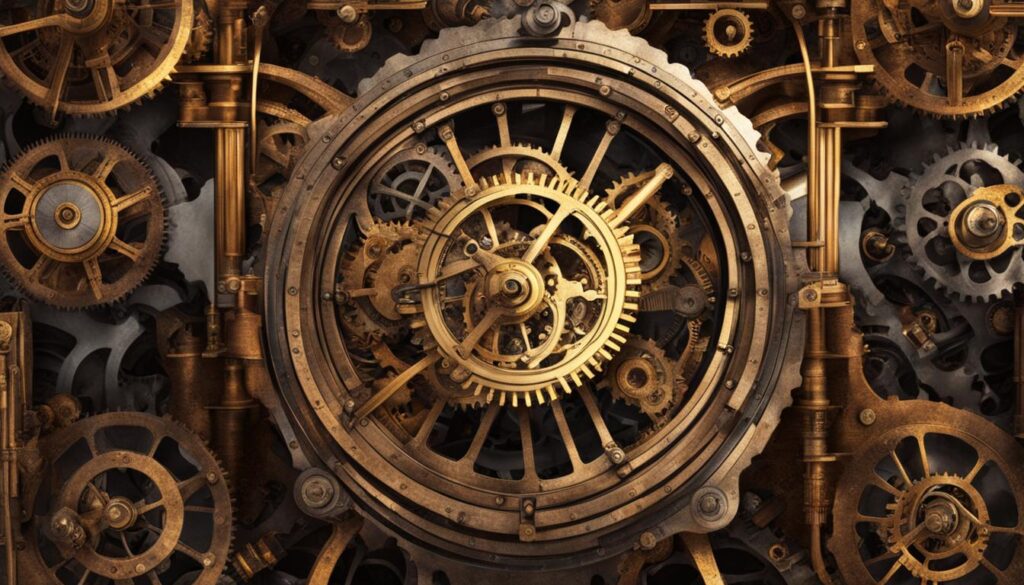
“Engineering is the soul of steampunk. It’s the marriage of art and mechanics, where craftsmanship meets imagination.” – Steampunk Enthusiast
Conclusion
Crafting functional steampunk machinery is a thrilling and rewarding endeavor that combines technical prowess with artistic creativity. By understanding the components and construction techniques of these mesmerizing devices, individuals can bring their own Victorian-inspired creations to life.
From boilers and engines to gears and gauges, every element plays a vital role in the overall functionality of steampunk machinery. The careful selection of materials, attention to detail, and innovative design choices are what set these projects apart.
Whether it’s a mesmerizing entertainment system or a mechanical masterpiece, the possibilities in designing mechanical steampunk projects are boundless. By embracing the spirit of steampunk and letting their imagination soar, enthusiasts can create truly unique and awe-inspiring functional devices.
So, roll up your sleeves, gather your tools, and embark on the adventure of crafting functional steampunk machinery. Let your creativity run wild, and watch as Victorian aesthetics blend seamlessly with innovative engineering, bringing to life a world of wonder and fascination.
FAQ
What components are important for crafting functional steampunk machinery?
Components such as boilers, burners/fuel, engines, flywheels, oilers/lubricators, governors, condensers, valves, water sight glasses, water pumps/tanks, gauges, insulation, and gears are essential for creating functional steampunk machinery.
How can I design mechanical steampunk projects?
When designing mechanical steampunk projects, it is important to consider both the overall aesthetic and functionality. Incorporate elements such as old radios, typewriter keys, brass, wood, and acrylic to create visually stunning and functional pieces.
What skills and tools are needed for assembling functional steampunk devices?
Assembling functional steampunk devices requires skills such as sewing, thrifting, woodworking, painting, leatherworking, metalworking, and crafting. Specific tools include sewing machines, sergers, edge-stitch feet, ruffle feet, irons, rotary cutters, cutting surfaces, leather hole punches, Dremels, bench grinders, brazing torches, and more.
How can I engineering steampunk mechanical projects?
Engineering steampunk mechanical projects involves a deep understanding of traditional engineering materials and techniques, as well as steampunk aesthetics. Metalworking is significant, and tools such as Dremels, bench grinders, and brazing torches are commonly used. However, proper training and caution are necessary due to potential dangers.
What does crafting functional steampunk machinery require?
Crafting functional steampunk machinery requires a combination of technical skills, creativity, and attention to detail. By understanding the components and construction techniques of steampunk machinery, individuals can design and assemble their own working creations.

